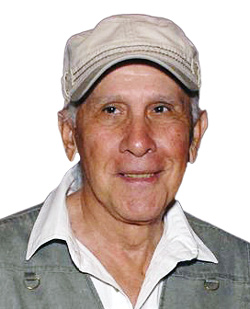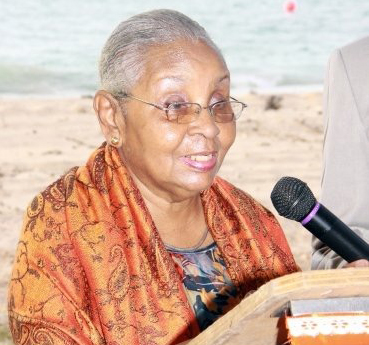November 20, 2019 issue
Authors' & Writers' Corner
lights a candle

There are few things more poignant at Christmas than a child writing to Santa Claus or Father Christmas as we called him, when I was a child growing up in British Guiana, decades ago. Even at that time, the idea of the mythical figure of Santa Claus was imbedded in the minds of children, in many places, far and wide. Santa Claus had different names but the persona was and is the same.
Historically, the idea of Christmas went through different stages from pagan celebrations, to days honouring the martyrdom of saints. There was much debate to settle on a particular day, December 25, to celebrate the birth of Jesus. Then along came Midnight Mass, the singing of carols, and into contemporary Christmas customs – Christmas trees, candle lights, Christmas cards, the giving and sharing of gifts.
In countries where the majority of the population is not Christian, many of the workers take the opportunity to take a rest from the daily drudgery of work, clean house, catch up on domestic tasks, and perhaps “drink a rum on a Christmas morning,” as the calypsonian would sing. Fireworks, processions, bawdiness, took to the streets – a good reason and opportunity to “let off steam”. In the Caribbean you knew that when Christmas comes, carnival cannot be far behind. Some took it as an opportunity or excuse to “practice” for carnival.
Fast forward to the present. Taking a holiday two summers ago with a Christian couple, and two young children, age 6 and 9, we visited a historic Catholic church. The younger of the two children looked up at a statue of Jesus on the cross and asked “Who is that Man?” The parent tried to explain Jesus. “Yes, but who is he?” the child persisted. The parents pressed on with other matters.
Sadly I thought. Yes. Who is that man on the cross in the modern world? What is His relation to Christmas? Santa Claus would have been recognized even if he was hanging from a cross, Disney characters would have been recognized, even demonic presidents would have been recognized!
I soon got my answer. I spent that Christmas with the selfsame family in the United States. The excitement built up and then came Christmas morning! A mountain of gifts surrounded a huge Christmas tree, with the overflow spreading half way across the living room. A mad scramble followed with the ripping of carefully and lovingly wrapped packages, the gift giver at times being totally ignored. Shouts of glee, followed at times with a tug of war between the two kids, a heap of garbage accumulating rapidly in the bedlam.
I sat with grandparents, uncles, aunts, parents watching the scene unfold. I had a wry smile on my face. I saw a grandmother shaking her head in disbelief. Some duplicate gifts appeared, some gifts appeared to be broken or non-functional, some were greeted with a groan of disgust: “Mummy I got that last year!” Some of the clothing did not fit or the style did not appeal to the recipient.
As parents tried to separate the useful from the useless among the gifts, I made a mental calculation of the costs. It could easily run into thousands of dollars! I compared that to the cheap, spring loaded train engine, no coaches, no tracks, that I got from Father Christmas one year when I was a child. That toy was broken before the morning was over. I ended up pulling it with a string for weeks and months after!
Where is the Man on the cross? Where is the baby in the manger? Where is the true message of Christmas – not in the home, not in the school, not in the conversation, not in the shops, and not in the media to all outward appearances.
Where is midnight mass in the churches, where was the nativity scene re-enacted? Where are the angels singing peace on earth to men and women, of goodwill? Where is that silent night, holy night? Almost gone and all but forgotten in a divided world.
After the food and festival, after the splurge of gift giving, after the overload of debt to be paid, gifts to be returned to the stores, after the party, there is a hollowness in me. There is a sadness that carries through to the New Year, to the hope for better things to come, not necessarily a return to the past, but an evolution to the future, to a better world, a safer world, a less divided world. A return to a planet that is going to be saved not recklessly thrashed by greedy and psychopathic leaders, to an age when truly wise and caring leadership will emerge, to a time when the Man on the Cross will be recognized and the lessons He taught and died for, starting with his birth in a stable in Bethlehem.
We pray that His star will shine and be seen from afar as the three Wise Men saw that first Christmas. I am still wishing and hoping this Christmas of 2019. However, as I have said before and I believe, in every dark place, some one is lighting a candle of hope and goodness tonight, someone is making a difference in the life of another, someone has seen and heard the baby Jesus! The true message of Christmas will live on! If the creeks don’t rise and the sun still shines, I’ll be talking to you.

By Romeo Kaseram
Marion Patrick Jones (also Glean, and O’Callaghan) was born on August 16, 1931, in Woodbrook, outside Port-of-Spain, Trinidad and Tobago. According to Wikipedia, her father Patrick Jones (1876-1965), was a mix of African-Chinese heritage, and was a leading Trinidadian trade unionist and socio-political activist at the turn of the 20th century. Also, Wikipedia adds he was a well-known calypsonian, with the lofty sobriquet “Cromwell, the Lord Protector”, but more colloquially known as ‘Chinee Patrick’; he was also a notable pyrotechnist in Trinidad and Tobago, and manufactured fireworks until the end of the 1920s.
The young Jones graduated from St Joseph’s Convent, which was an exclusive, highly-regimented Roman Catholic girls’ school in Port-of-Spain run by Irish nuns. Harold Barratt, writing in Fifty Caribbean Writers: A Biobibliographical Critical Sourcebook, tells us her schooldays were remarkable and formative, that the “regimen of St Joseph’s, the nuns’ asceticism, the profound influences upon the developing consciousness of the young girls”, were all “effectively transmuted into her fiction work and provide much of the dramatic tension in several sections of her novels”.
In 1950, she won the Girls’ Open Island Scholarship, placing third; as an aside, the English writer who was born in Trinidad, V.S. Naipaul, was also a beneficiary of a similar scholarship. Following high school, Jones attended the Imperial College of Tropical Agriculture, St Augustine, noted by Wikipedia as “one of the first two women to be admitted”; the College later grew into the St Augustine campus of the University of the West Indies. Jones then traveled to New York City, attending school there and earned a diploma in library science. Wikipedia notes she paid tuition fees by working in a factory painting its ceramic wares; while there, she also had exposure to the trade union movement.
Barratt tells us Jones spent a year in Brooklyn, then returned to Trinidad where she worked at the Carnegie Library in San Fernando, south Trinidad. However, a short while later she was again on the move, Wikipedia telling us 1960s saw Jones continuing studies in Britain, and graduating with a Bachelor of Science from the University of London. Her postgraduate studies were done in social anthropology at the London School of Economics, where she finished with a thesis on the Chinese community in Trinidad, Wikipedia tells us. Also, as Barratt writes, “during her time in London [she was] one of the founders of [Campaign Against Racial Discrimination]”.
Jones was Director of Social Science Programmes for UNESCO in Paris from 1965-1990, and in charge of its anti-apartheid programme, Wikipedia tells us; she was also writing non-fiction during this time, particularly on Africa, using her married names, Marion O’Callaghan, or Marion Glean. Published under Marion Patrick Jones, she wrote two novels, the first Pan Beat (1973), about steelband and the involvement of women in its development; the second novel, J’Ouvert Morning (1976), examines middle-class predicaments in a society with a colonial heritage. Barratt says of her novels: “[She] has written rather courageously about the ‘petty and ridiculous’ of Port-of-Spain”, while adding, “Far from being embarrassed by the derelict locations and fetid slums of Trinidad’s capital city, she examines with detailed and sometimes brutal candor the harried lives of the men and women who live there, drawing one’s attention… to ‘the dirtiness of the streets, the life overflowing to the street corners, rats rummaging by the side of the road, the overpowering scent of lavatories and dead animals’.”
Critical commentary on Jones’ novels are in agreement, as Lloyd W. Brown also cites in the website, biography.jrank.org, on “the soap operatic quality of [Jones’] narrative materials”; however, despite this, he maintains her “novels succeed as riveting documents of a troubled society in a state of transition. ...despite Jones’ melodramatic tendencies, the characters are vividly drawn and the language – especially in J’Ouvert Morning – [are] original and invigorating”.
Barratt thinks Pan Beat is the better of both novels, with its writing “facile and coherent, and the major characters… drawn in depth and with insight and sensitivity”. He adds, J’Ouvert Morning shows signs of careless composition and, alas, little revision. The tautness of Pan Beat is missing; the writing is often desultory, the syntax uncommonly clumsy, and Jones’ attempts at stream of consciousness, which works rather effectively in the first novel, peter out into a disconcerting incoherence.” He maintains J’Ouvert Morning should not be dismissed, noting, “it is full of penetrating insights into Trinidadian and, by extension, West Indian society; and some of the characters… are potentially fascinating and deserve… a better-crafted novel”.
Yet, despite the critical reception negatives, the novels are still lifted into a literary and worthy space with what Barratt admits are “pungent and disquieting explorations of Trinidad society in both the pre- and post-independence period”. Jones’ writing is also remarkable for its pioneering honesty in the willingness by the novelist to not avert her eyes, and so, as Barratt notes, both novels “explore areas sometimes considered too banal and insignificant for serious literary treatment”, such as the slums and lower middle-class areas of Port-of-Spain. This pioneering, foundational focus indigence in the city of Port-of-Spain, for example, would later begin to appear in works by Earl Lovelace, such as in While Gods Are Falling (1965), and The Dragon Can’t Dance (1979).
Jones’ other writings appear in such collections as Her True-True Name: An Anthology of Women's Writing from the Caribbean (eds Pamela Mordecai and Betty Wilson, 1989); Caribbean Women Writers: Essays from the First International Conference (ed. Selwyn R. Cudjoe, 1990); and Daughters of Africa: An International Anthology of Words and Writings by Women of African Descent (ed. Margaret Busby, 1992). She also wrote a weekly newspaper column for the Trinidad Newsday as Marion O’Callaghan.
Jones was married to Benedict Glean, and to the late Maurice O'Callaghan. Wikipedia tells us O’Callaghan traveled to Trinidad from Cork in Ireland to help establish the Presentation Brothers’ school, Presentation College, in San Fernando at the end of the World War II. She lived in Trinidad following retirement from UNESCO in 1990, and passed away at 84 years old on March 2, 2016.
(Sources for this exploration: Wikipedia; Fifty Caribbean Writers: A Biobibliographical Critical Sourcebook; and the website, biography.jrank.org.)